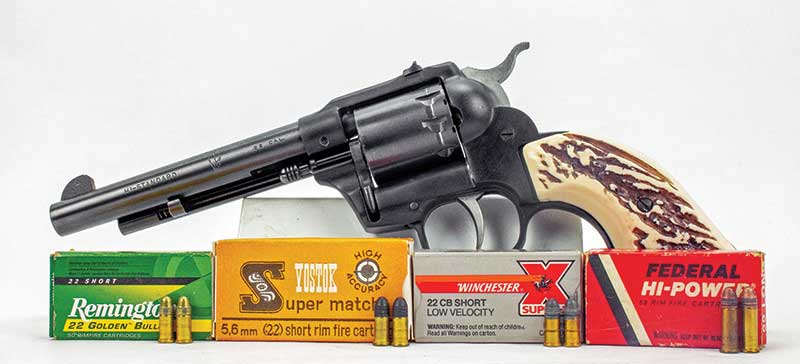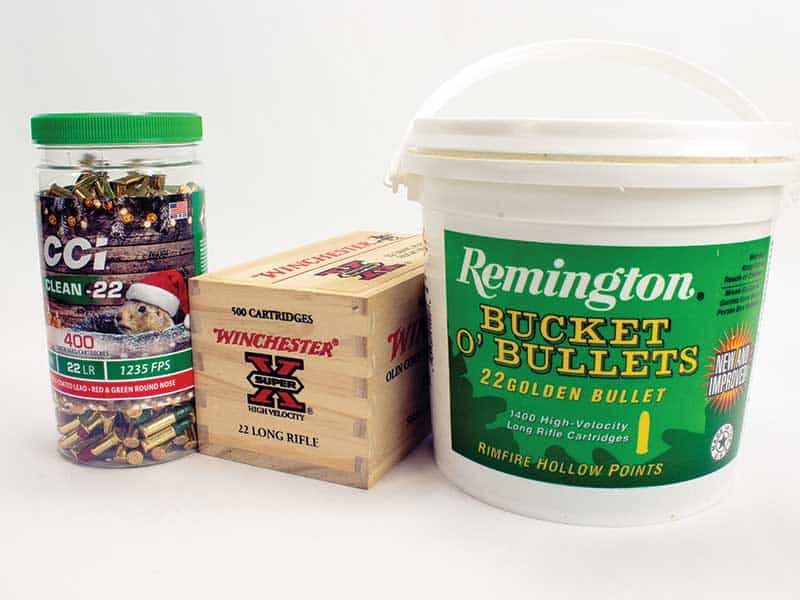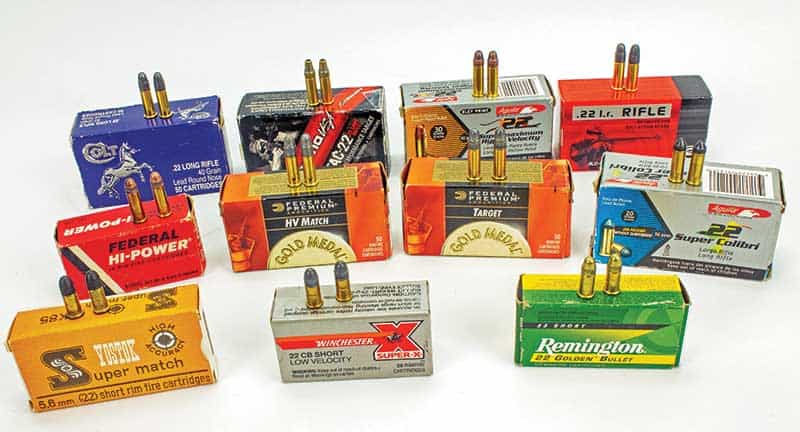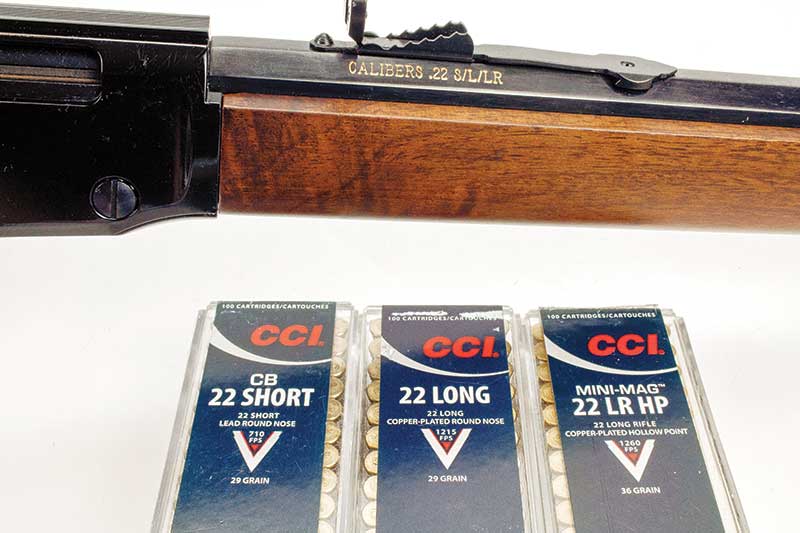The Long And Short
Of .22 Ammo
160 Years Of Rimfire Magic
The other day I picked up one of my dad’s old cigar boxes from a shelf in my ammo closet and was surprised at how heavy it was. Opening it, I found it was nearly full of .22 ammo I’d evidently thrown together for an outing with some of the grandkids but had just forgotten about. Some of it appeared to have come from my dad’s house when we cleaned out his stuff some years earlier. One of the shelves in front of me was loaded with .22 rounds so it wasn’t like I was missing it. However, the variety of stuff in the box got me thinking.
Choices
When I was a kid, 50 cents bought a box of .22 Shorts, tax included. Those Shorts were great for plinkin’ with my High Standard Double Nine revolver or my Remington 514 single-shot rifle. For something serious like squirrel hunting, I opted for .22 Long Rifle hollow points. Sometimes I shot .22 Longs simply because it was the only thing on the shelf at the hardware store.
Fifty cents for a box of ammo! Those days are long gone, but prices are coming down again. Some days I bought .22 Shorts because I only had two quarters and Longs or Long Rifles would have cost 10 or 15 cents more. Shorts are great for short distance target practice, and they’re relatively quiet. We never used hearing protection in those days.
Why Three?
Ever wonder why we have three .22 rimfire cartridges? The .22 Short was developed in 1857 for the Smith & Wesson Model 1. There’s a bit of history here because the Model 1 was Smith & Wesson’s first revolver and the .22 Short round was the first rimfire cartridge to replace the cap & ball in commercial revolvers. This first .22 cartridge had a 29-gr. bullet pushed by 4 grains of black powder. It wasn’t called Short until the .22 Long came along in 1871. It’s interesting to me in these days of “is 9mm really enough?” the .22 Short was originally developed for self-defense. As stronger handgun cartridges became popular, the .22 Short was more or less relegated to recreational shooting in shooting galleries at fairs and arcades.
When the .22 Long was developed, it also used the 29-gr. bullet but with more powder than the .22 Short. It was still originally a black powder cartridge and although it was designed with revolvers in mind, several rifles were developed to use this cartridge for hunting small game.
The J. Stevens Arms & Tool Company extended the case of the .22 Long and added a 40-gr. bullet to produce the .22 Long Rifle, commonly called LR. The .22LR cartridge was available beginning in 1888, in Stevens Arms #1, #2, #9 and #10 break-top rifles. The superior hunting and target shooting characteristics of the LR round initially rendered the .22 Long obsolete, but mystery of mysteries, we still have them today.
Most of the popular pump and lever action rifles of the time were chambered just for one type of .22 rimfire. Of course, most single-shot rifles would handle whichever one you choose to shoot. As the rifle models matured, some of the tube-fed rifles began to handle all three, even mixed together. Examples were the Winchester Model 1906, Marlin Model 20, Marlin Model 39A and Remington 572 Fieldmaster. Today, I have a Henry lever-action rifle which will handle Shorts, Longs and Long Rifles interchangeably though I’m perplexed as to why I would need this capability unless facing an end-of-ammo scenario and still needing dinner.
The .22LR is by far the most popular today with bullet weights ranging from 20 to 60 grains and all kinds of styles — lead, copper plated, round nose, hollow points — and even shotshells for dispatching rats or snakes.
Magnum, Too
Most discussions about .22 cartridges include the big brother of the lot, the .22 Winchester Magnum, also called the .22 WMR, .22 Magnum or .22 Mag. There is often confusion because of the different names but there is no difference. They’re all the same, it’s just marketing/branding hype.
You can’t chamber a .22 Magnum in a .22 rifle, and you can only shoot them in a .22 revolver if you swap out cylinders. While the bullet diameter is nearly the same, the cartridges are bigger. Bullet weights in the .22 Magnum range from 30 to 50 grains with velocities ranging from 1,500 to 2,200 feet per second. The Magnum cartridge hits harder over longer ranges with more muzzle energy making it a better choice for varmints unless they’re very close. I love shooting .22 Magnum handguns with my grandkids because they are loud, have a lot of muzzle flash but very little recoil.
So Much Variety
My stash of .22 cartridges, some of them going back years, got me to wondering just what was in there. I found some old boxes of .22 Shorts made by Remington and Winchester. The oldest box I have in my collection is a box of Federal Hi-Power .22 Longs in a box the company used from 1967 to 1972. These cartridges are copper plated, wax lubricated and were manufactured in Minneapolis. I’m thinking those were my dad’s. My CCI stash has CB Shorts and CB Longs. These have conical bullets and very light power loading, great for revolver plinking at close range. The regular .22 Shorts add some gusto to the plinkin’ game and a little more accuracy. Some of the boxes are labeled high velocity and others low velocity. I found a box of Longs made with primer-only and a 20-gr. bullet, made by Mexican manufacturer Aguila. In fact, I have several boxes of Colt-branded .22LR, with the Rampant Colt on the box, but actually made by Aguila.
Range Time
So many differences — I had to go shooting! Instead of a typical ammo or gun evaluation, my goal was just to have fun. But I can’t help it. My mind just works in organized patterns, so I took my Taurus 992 revolver with a 6″ barrel and both .22 and .22 Magnum cylinders. I lined up .22 CB Short, .22 HV Short, .22 CB Long, .22 Long, 22 Long Rifle and .22 WMR cartridges. They were all CCI except for the Short HV which were Remington. Firing them in order, 9 rounds each type, each at a separate target 10 yards away, I was successful at getting my rounds on target, regardless of cartridge type. The Longs and Long Rifles grouped the best, but I’d have been killing squirrels or rabbits with any of them. I think the most fun was the sound — super quiet, quiet, sort of quiet, kind of loud, loud and real loud!
Variety Is The Spice Of Life — And Shooting!
Much of my stockpile was the result of a severe shortage back in 2012–2014, and when it eased up I just started buying .22 ammo whenever I could. Starting with CCI, Winchester and Remington, I’ve got Russian-made .22 ammo by Vostok, German RUAG’s Geco ammo and CCI’s Christmas offering of Clean .22 with red and green poly-coated lead round nose bullets. I won’t say .22 ammo is cheap, but it’s a lot less expensive than 9mm and other centerfire calibers, so have some fun and shoot some .22.










